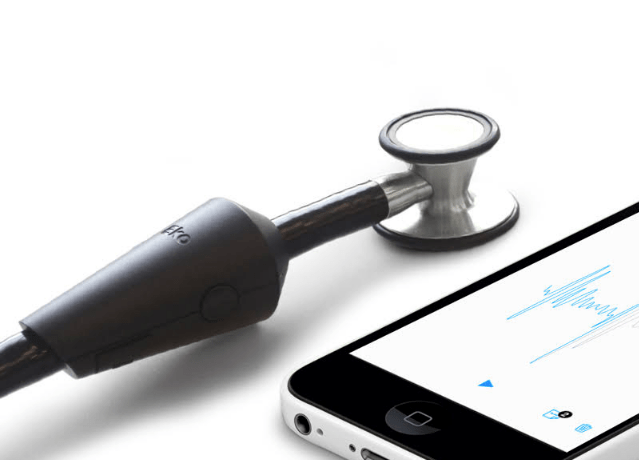
The stethoscope, that quintessential tool of doctors, has been upgraded several times since it was invented two centuries ago. Eko Devices, a startup led by three recent graduates of the University of California, Berkeley, is betting that it is time for another innovative overhaul.
The company received approval last Friday from the Food and Drug Administration to market its Eko Core, a digital device that attaches to a conventional stethoscope and allows it to record, amplify and wirelessly send audio and sound wave images to an iPhone application.
Its software meets federal standards for privacy and security, the founders say, and it can transmit its heart sounds and waveforms to the electronic health records used in hospitals and clinics. An Android app is scheduled to be released early next year. The Eko Core device went on sale two weeks ago, priced at $199. A complete stethoscope with the same capabilities will sell for $299.
Cardiologists at the Mayo Clinic, Stanford and the University of California, San Francisco, who have seen and sampled the Eko technology, are initially impressed.
“This is probably one of the most important innovations in the plain old stethoscope in recent years,” said Dr Charanjit S Rihal, chairman of the department of cardiovascular diseases at the Mayo Clinic.
The stethoscope was invented in 1816 by a French physician, Dr Rene Laennec. His first version was essentially a hollow wooden tube, and embarrassment, it seems, was the impetus for his invention. He was apparently uncomfortable putting his ear on women’s chests to hear their heartbeats.
The device’s materials and acoustics have improved steadily over the years, and digital stethoscopes have been available for about two decades. But the previous generation of digital models, cardiologists say, was often bulky and complicated to use and was not able to send recordings and data wirelessly to a smartphone.
The Eko technology, said Dr Robert Harrington, a cardiologist and chairman of the department of medicine at the Stanford School of Medicine, has “the potential to improve a physician’s diagnostic acumen” by enabling a doctor to hear and see the pattern of a patient’s heart rhythms in greater detail. He also identifies a benefit in the ability to store the heart sounds in a patient’s electronic record, so doctors can compare sounds from a recent visit with ones from a year or two earlier.
Harrington plans to use the Eko technology as a teaching tool at the Stanford medical centre with the next crop of physician residents, making use of the digital recording and wireless sharing capabilities. “They can hear while I listen and describe different heart sounds,” he explained.
The seed of the idea that became Eko was planted at a class that Connor Landgraf, a bioengineering major, attended in his senior year at Berkeley. A researcher from the University of California, San Francisco, spoke to the class about gaps in modern medical technology.
In particular, he pointed to the challenge of interpreting heart sounds and accurately detecting abnormalities, especially for most physicians, who do not spend years listening to heart rhythms, as cardiologists do.
Landgraf, now 25, who has experienced occasional heart palpitations, was intrigued. “It was the inspiration for this company,” he recalled. He persuaded two undergraduates – Jason Bellet, 23, a business major, and Tyler Crouch, 23, an engineering major and software developer – to join him. The pitch, Bellet recalled, was the opportunity to “bring the stethoscope into the 21st century.”
There are cardiologists who regard the stethoscope as a relic that should be jettisoned, given the scientific precision of ultrasound technology and echocardiograms.
At first, members of the Eko team thought that they would reimagine heart sound detection in a way that would be less costly than ultrasound but with a device that would look very different from a traditional stethoscope. An early prototype resembled a hockey puck, Landgraf recalled.
When they took their idea to doctors, they learned a lesson. “Physicians love their stethoscopes,” Landgraf said. “It was shocking to us, but really important.” After seven months, in early 2014, the Eko team had a prototype that resembled its current product.
Other ventures
Beyond its devices and mobile app, the company is developing a decision-support software algorithm that compares a patient’s heart rhythms with a cloud-based data library of he-art sounds. The smartphone app then classifies the patient’s result as normal or abnormal.
The University of California, San Francisco, medical school has begun enrolling patients for a clinical trial to test the diagnostic reliability of the Eko algorithm. In the trial, the predictions of the Eko algorithm will be compared with echocardiograms for the same patients.
The principal investigator in the clinical trial, Dr John Chorba, is the researcher who spoke to the Berkeley class and inspired Landgraf two years ago. “You have all this data collected by the device, but the question is whether the software can identify pathological heart sounds,” Chorba said.
“I’m not a big-data person or a computer scientist,” he said, “but as the device gets used, you get more data, and accuracy should improve.”
Chorba said the clinical trial would most likely take about a year. The decision-support software will undergo a separate review by the FDA. Chorba, Harrington and Rihal are all unpaid advisers to Eko Devices.

